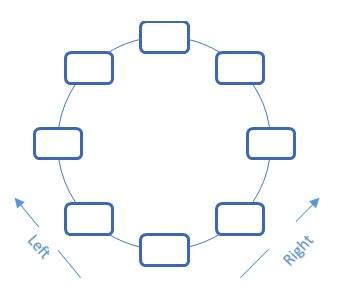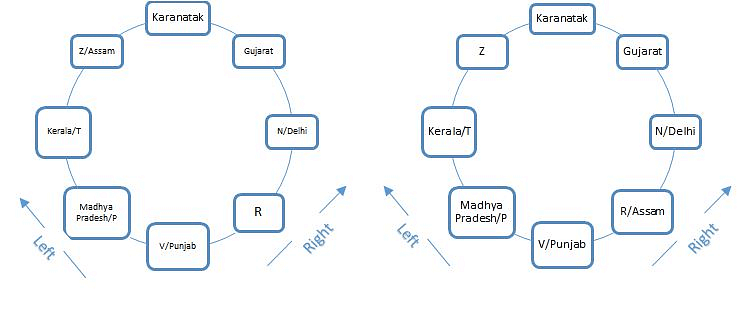Linear & Circular Arrangement | Logical Reasoning (LR) and Data Interpretation (DI) - CAT PDF Download
Importance of Linear & Circular Arrangement
- Seating Arrangement questions in the Logical Reasoning section are renowned for their complexity, time-consuming nature, and the mental effort they demand. It's crucial to acknowledge their significance, especially in exams like CAT, where approximately 3-4 questions are dedicated to this topic.
- The accurate resolution of these questions can significantly elevate your percentile. However, it's equally essential to recognize that even a minor error can have substantial consequences due to negative marking. Thus, mastering these questions becomes a key aspect of optimizing overall exam performance.
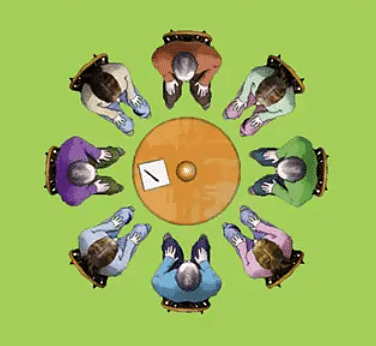
- We can identify that these problems can be categorized into two types:
(a) Linear Seating Arrangement Problems
(b) Circular Seating Arrangement Problems
Linear Seating Arrangement
As the name suggests, linear seating arrangement problems are those where arrangements are made in rows or lines. The arrangement can be in a single row, or there can be multiple rows, but generally, two-row questions are asked.
1. One Row Problems
One-row problems are those when the arrangement is made in a single line.
These problems can be divided into two types of conditions:
- In which direction of the face is not given; in these, we assume direction according to our reference.
- In which direction of the face is given like facing north, south or towards east, west; in these, we must plan to keep in mind these directions.
2. Two Row Problems
In the two-row arrangement, objects are arranged in two different rows facing each other. Now we can move on to solve an example of linear arrangement so that we have a better understanding of these types of questions.
But before moving forward with an example, keep in mind these important points:
- Always note the conditions given in the short form and represent them pictorially.
If A is sitting to the immediate left of B, then it also means that B is on the immediate right of A.
If not specified, assume that all people are facing towards the centre or North (until and unless the direction is specified).

If you are unable to get any useful information from a sentence then better skip that line and move on to the next line. Then re-examine the skipped sentence after going through other sentences.
The meaning of and, who & adjacent in seating arrangement questions:
Example: A sits third to the right of P and sits fourth to the right of T. It denotes A sits third right of P, A sits fourth right of T i.e. the given information is talking about the first person.Adjacent means next to each other, not opposite to each other.
Example: A and B are adjacent to each other, which means they are immediate neighbours of each other.If “who” is given in a sentence, for example, A sits third to the right of P who sits fourth to the right of T. It denotes A sits right of P, P sits fourth right of T, and the given information is talking about the second person.
Steps to Solve Linear Arrangement Questions
1. Visual Representation
- Following the comprehension of the reasoning scenario, create a visual linear sequence based on the given set's object count.
- For instance, if the query instructs the arrangement of 5 individuals – Abdul, Birbal, Chaman, Druv, and Ehsan – in a line based on their heights from tallest to shortest, and stipulates that no two of them share the same height, then:

2. Use Symbols to Represent the Condition Given
- For instance, if the given condition states that Abdul is taller than Dhruv but shorter than Ehsan, this condition can be symbolically denoted as E>A>D.
- Another scenario might indicate that there exists exactly one person shorter than Birbal but taller than Chaman. A symbolic representation of this condition could be expressed as B _ C.
- The ways to symbolically represent conditions are diverse, with no universally standardized approaches. It is advisable for students to formulate their own symbolic representations, prioritizing clarity and individual comfort.
3. Combine the Constraints to get the Optimal Solution.
- After representing the conditions the final step should be to optimize the constraint such that it meets all the conditions.
- This is the most critical step where the students' reasoning prowess and ability to organize the data come out in the open. With adequate practice, the right approach, and determination one can overcome this challenge.
Examples of Linear Arrangement
Example.1.
Direction: Study the following information and answer the given questions.
Pawan, Qaseem, Rajan, Suresh, Tariq, Uzma, Waseem, and Zainab are sitting in a line facing north. Zainab sits third to the left of Suresh. Zainab sits at the extreme end of the row. Only one person sat between Suresh and Qaseem. Only two people sit between Qaseem and Waseem, who is an immediate neighbour of Pawan. Uzma sits third to the left of Rajan.
Q: Who is an immediate neighbour of Tariq?
Sol:
People: Pawan, Qaseem, Rajan, Suresh, Tariq, Uzma, Waseem, and Zainab.
1) Zainab sits third to the left of Suresh.
2) Zainab sits extreme end of the row.
3) Only one people sit between Suresh and Qaseem.
4) Only two people sit between Qaseem and Waseem, who is an immediate neighbor of Pawan


5) Uzma sits third to the left of Rajan

Hence, Qaseem and Rajan is an immediate neighbor of Tariq
Example 2
Directions: Ten people– A, B, C, D, E, P, Q, R, S, and T are sitting in two rows with five persons in each row namely row-1 and row-2. Each person in row-1 is facing north and each person in another row is facing south. Each person in row 1 faces a person of another row. A, B, C, D, and E are facing towards north while P, Q, R, S, and T are facing to- wards the south but not necessarily in the same order
E is not an immediate neighbor of D. Neither P nor S sit at any of the extreme ends of the row. Q is an immediate neighbor of S and facing E. D is facing the person who is sitting 2nd to the right of the person who faces C. P is sitting 2nd to the right of S. T sits at one of the extreme ends but doesn’t face C. B is sitting to the left of D. R sits second to the left of T.
Q: If row-1 people sit in alphabetical order starting from the left end then who will face S?
Sol:
1) D is facing the person who is sitting 2nd to the right of the person who faces C.
2) B is sitting to the left of D.
3) P is sitting 2nd to the right of S.
4) Neither P nor S sit at any of the extreme ends of the row.

5) R sits second to the left of T
6) T sits at one of the extreme ends but doesn’t face C

7) E is not an immediate neighbor of D. Using statement 7, Case 1.B will be eliminated.
8) A sits to the left of E

D will face S if persons of Row 1 are arranged according to alphabetical order. So, the correct answer is D
Circular Seating Arrangement
The circular seating arrangement is that type of seating arrangement where people are sitting or standing in a circular, square, or polygonal way.
There can be three types of distinctive forms of questions under this:
• Circular arrangement where people face the centre of the table.
• Circular arrangement in which people face outward of the table.
• Circular arrangement with some people facing the centre of the table while some people facing outward of the table.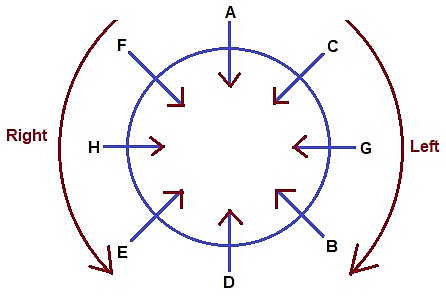 Circular ArrangementThere can be two cases depending upon the facing of people:
Circular ArrangementThere can be two cases depending upon the facing of people:
Case1: When people are facing inwards or centre of the table then
(i) All their “rights” refer to the anticlockwise direction.
(ii) All their “left” refer to the clockwise direction.
Case2: When people are facing outward of the table
(i) All their “left” refer to the anti-clockwise direction.
(ii) All their “rights” refer to a clockwise direction.
Tips and Tricks to Solve Circular Arrangement Reasoning Questions
Candidates can find various tips and circular arrangement reasoning tricks below for solving the questions related to the Circular Arrangement Reasoning section.
Tip 1: Circular Arrangement can be of clockwise and anticlockwise directions.
Tip 2: Practice mock tests and quizzes as much as possible to get well-versed with all the topics and their question patterns to score well in the circular arrangement reasoning section.
Examples of Circular Arrangement
Example.3.
Consider an example now, representatives from eight different states viz. L, N, P, R, T, V, X and Z are sitting around a circular table facing the centre but not necessarily in the same order. Each of them is from a different state namely, Maharashtra, Assam, Gujarat, Kerala, Karnataka, Delhi, Madhya Pradesh and Punjab.
V sits second to the right of the representative from Kerala. A representative from Madhya Pradesh is to the immediate right of the representative from Kerala. N is third to the right of the representative from Madhya Pradesh. T is to the immediate left of P. Neither P nor T is an immediate neighbour of either N or the representative from Gujarat who sits second to the right of R. R is neither the representative of Kerala nor Madhya Pradesh. X and the representative from Maharashtra are immediate neighbours of each other. N is not the representative of Maharashtra. Only one person sits between P and a representative from Assam. Z sits third to the left of the representative from Punjab. A representative from Delhi sits second to the left of the representative of Karnataka. L is not the representative of Assam.
Now before moving forth to the solution, understand these basic steps that will help us solve this problem:
(i) Read the question carefully and note down the name or the characters that have to be arranged carefully.
(ii) Check and write down whether all the character is facing towards the centre or outwards or haphazardly some facing towards while others outward.
(iii) Now we will use diagrammatic representation to solve the question. Draw a circle with equidistant points and with the help of arrows signify the direction in which the characters are facing.
(iv) After this start reading the information and allot the places to the characters according to the information given in the question.
(v) Make cases for multiple possibilities and then rule out those cases that don’t fit the given information in the question.
(vi) Similarly go on deducing the cases and reach out to one possible case, which is the solution and eliminate all others.
Sol.
Now we will use the above steps and formulate the solution above problem:
In the above example, we are given 8 alphabets each corresponding to 8 states.
Representatives: L, N, P, R, T, V, X and Z
States: Maharashtra, Assam, Gujarat, Kerala, Karnataka, Delhi, Madhya Pradesh and Punjab.
- We need to map representatives to their states, respectively.
- Now first we will make a circle with 8 equidistant lines and respectively add the direction in which the representatives are facing.
- Since all are facing towards the centre, everyone’s right is in the anticlockwise direction and everyone’s left is in the clockwise direction.

Now we will read the main problems and try to get direct information. According to the problem:
1. V sits second to the right of the representative from Kerala.
2. A representative from Madhya Pradesh is to the immediate right of the representative from Kerala.
3. N is third to the right of the representative from Madhya Pradesh.
Here, we will first place V at the bottom-most place. We then place the representative from Kerala second to the left of V. This is because V sits second to the right of the representative from Kerala. Then we place the representative from Madhya Pradesh and N as given in the problem. So, we get the following figure. Now no other direct information is given with which we can plot the diagram. So, we move on to the next statements.
Now no other direct information is given with which we can plot the diagram. So, we move on to the next statements.
4. T is to the immediate left of P.
5. Neither P nor T is an immediate neighbour of either N or the representative from Gujarat. So, we get three possible cases.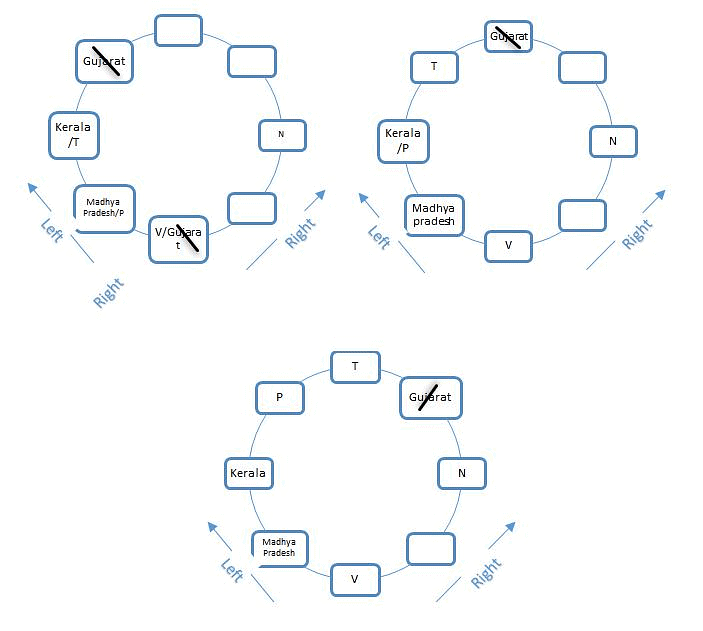 6. Representative from Gujarat sits second to the right of R.
6. Representative from Gujarat sits second to the right of R.
7. R is neither the representative of Kerala nor Madhya Pradesh.
So the third case gets eliminated as there is no place left for Gujarat.
Thus, cases 1 and 2 get amended, as shown below:
 8. Only one person sits between P and the representative from Assam.
8. Only one person sits between P and the representative from Assam.
We know the possible positions of P so we can place a representative from Assam accordingly.
Here for each case, we get 2 cases, so now we have a total of 4 cases.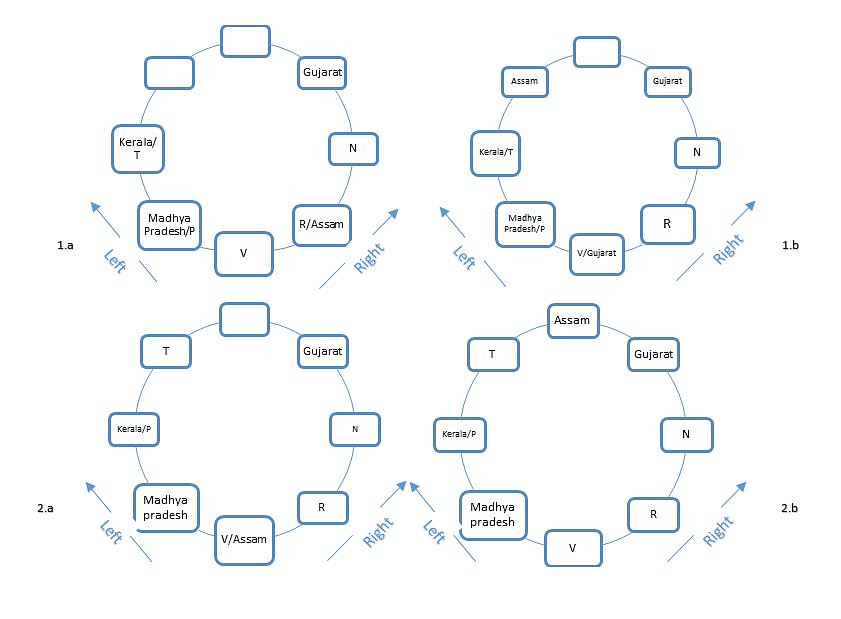 9. Z sits third to the left of the representative from Punjab.
9. Z sits third to the left of the representative from Punjab.
10. A representative from Delhi sits second to the left of the representative of Karnataka.
Plotting information given in these statements, possibilities 2. a and 2. b get eliminated. We can see this as below:
When we see in cases 2. a and 2. b we have 4 places for these two representatives (Delhi & Karnataka).
Now, in case 2:
(A)
(i) If we place the representative of Delhi as R, there is no place for a representative of Karnataka.
(ii) If we place the representative of Delhi as N, it is possible.
(iii) If we place the representative of Delhi to the left of T, there is no place for a representative of Karnataka.
(iv) If we place the representative of Delhi as T, there is no place for the representative of Karnataka.
So placing a representative of Delhi as N is possible as shown below.
The diagram looks like this.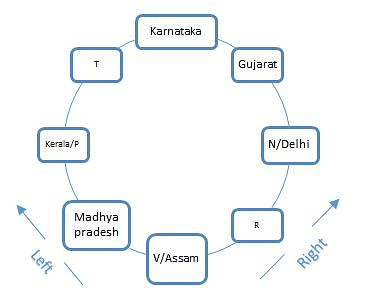 Now we take the 9th statement and try to reason out 2. a again.
Now we take the 9th statement and try to reason out 2. a again.
There are 3 possible places for Z (As a representative of Madhya Pradesh, a representative of Gujarat or a representative of Karnataka)
(B)
(i) Madhya Pradesh is not possible as there is no place for representatives of Punjab.
(ii) Similarly, Gujarat and Karnataka are also not possible.
- Thus case 2. a is eliminated.
- On a similar basis, case 2. b is also getting eliminated.
- Thus case 1 remains.

(11) X and the representative from Maharashtra are immediate neighbours of each other.
(12) N is not the representative of Maharashtra.
(13) L is not the representative of Assam.
From this statement, we get that only case 1. a is valid all else gets eliminated.
Hence, we get the final seating arrangement diagram of the circular arrangement as follows.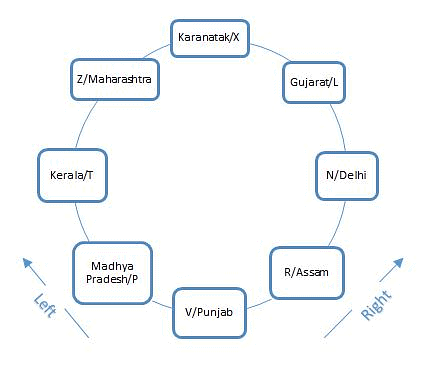
Solved Questions
Directions for the following three questions: Answer the following questions based on the statements given below:
(i) There are three houses on each side of the road.
(ii) These six houses are labelled as P, Q, R, S, T, and U.
(iii) The houses are of different colours, namely, Red, Blue, Green, Orange, Yellow and White.
(iv) The houses are of different heights.
(v) T, the tallest house, is exactly opposite to the Red coloured house.
(vi) The shortest house is exactly opposite to the Green coloured house.
(vii) U, the Orange coloured house, is located between P and S.
(viii) R, the Yellow coloured house, is exactly opposite to P.
(ix) Q, the Green coloured house, is exactly opposite to U.
(x) P, the White coloured house, is taller than R, but shorter than S and Q.
Q1: What is the colour of the house diagonally opposite to the Yellow coloured house?
a) White
b) Blue
c) Green
d) Red
e)none of these
Ans: Option (D)
Sol:
There are three houses on each side of the road => Draw 6 lines, 3 in each row, to accommodate P, Q, R, S, T, and U.
The houses are of different colours and different heights.
T is the tallest and is opposite to the red house => Let’s number T as 1.
The shortest house is opposite to greenhouse.
U is orange and is between P and S => Two cases arise here. P-U-S is one possibility and the other possibility is S-U-P.

R is yellow and is opposite to P.
Q is green and is opposite U. We know that the greenhouse is opposite the shortest house. This implies that U is the shortest house => Number of U is 6.
P is white and is taller than R but shorter than S and Q => Apart from T, S and Q are also taller than P => S and Q can be 2 and 3 in any order => Number of P is 4 and the number of R is 5.
We know that P is opposite to R and Q is opposite to U => S is opposite to T
It is given that T is opposite to red house => S is the red house and hence T is the blue house.
So, we know the colours of all houses and the heights of P, R, T, and U.
In this question, we are asked to find the house that is opposite the yellow house. R is the yellow house, P is opposite to R and S is on the other corner in P’s row. Hence S is the house that is diagonally opposite to the yellow house and the colour of S is Red.

Q2: Which is the second tallest house?
a) P
b) S
c) Q
d) R
e)cannot be determined
Ans: Option (E)
Sol:
We only know that the second tallest house is either Q or S. Hence the answer cannot be determined.
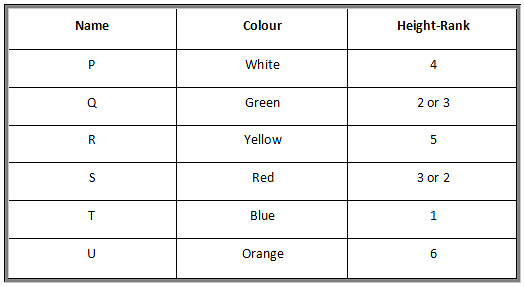
Q3: What is the colour of the tallest house?
a) Red
b) Blue
c) Green
d) Yellow
e)none of these
Ans: Option (B)
Sol:
We know that P is opposite to R and Q is opposite to U => S is opposite to T
It is given that T is opposite to red house => S is the red house and hence T is the blue house.
T is the tallest house and hence the colour of the tallest house is blue.
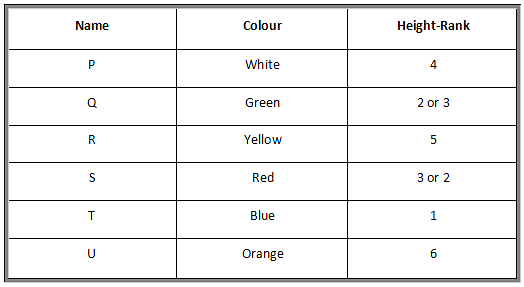
Try Yourself
Direction: Each of these questions is based on the information given below :
- 8 people E, F, G, H, I, J, K and L are seated around a square table - two on each side.
- The 3 ladies are not seated next to each other.
- J is between L and F.
- G is between I and F.
- H, a lady member is second to the left of J.
- F, a male member is seated opposite E, a lady member.
- There is a lady member between F and I.
|
92 videos|123 docs|94 tests
|
FAQs on Linear & Circular Arrangement - Logical Reasoning (LR) and Data Interpretation (DI) - CAT
| 1. What is the significance of linear and circular arrangements in competitive exams? |  |
| 2. How do I approach solving linear seating arrangement questions? |  |
| 3. What are some common tips for tackling circular arrangement reasoning questions? |  |
| 4. Can you provide examples of linear arrangement questions commonly asked in exams? |  |
| 5. What are some frequently asked questions related to circular arrangements in exams? |  |
|
92 videos|123 docs|94 tests
|




